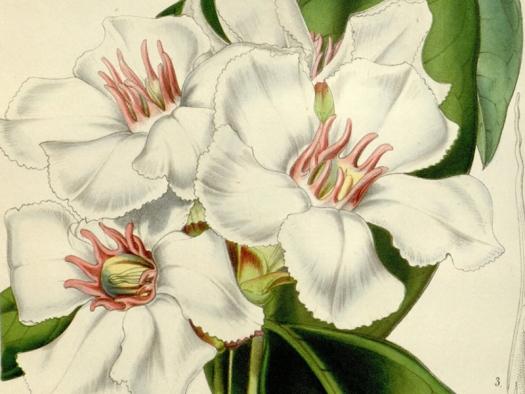StrophanthusGratusIllustration.jpg

Illustration by L. van Houtte in Flore des serres et des jardin de l’Europe, vol. 6: p. 181 ©1850 / CC BY-NC-SA 4.0
Strophanthus gratus
Could it be that the best treatment for heart disease was already discovered over 150 years ago, but nowadays even alternative medicine has forgotten about it?
If you or your loved ones face the challenge of heart problems, I think your worries will diminish after reading about ouabain.
A brief summary of the ouabain story
In 1861, on the famous Livingstone expedition in Africa, the English botanist John Kirk experienced the sudden disappearance of his heart problems after brushing his teeth. Curious to find an explanation, he noticed that his toothbrush had been in contact with seeds he’d collected from the indigenous people. They used these seeds, from the strophanthus plant, to create a deadly arrow poison.
Back in Europe, these seeds were analyzed and the extracted g-Strophantin was introduced in Germany as a potent heart remedy in the early 20th century.
The advocates – highly respected researchers and authorities in heart medicine at that time – called ouabain (the English word for the compound g-Strophantin) one of the greatest breakthroughs in heart medicine. Ouabain was known as “the insulin of the heart” and the advocates announced that “The time will come, in which failure to timely start ouabain therapy will be condemned as medical malpractice.”
However, due to the sometimes poor quality of the supplied seeds and unreliable preparation methods, there was always discussion about whether ouabain or another popular heart remedy was better suited to treat the heart.
Ouabain was used for many decades throughout Germany by thousands of doctors with great success in treating heart failure.
Dr. Sroka, a German physician who has been treating many of his patients with this remedy over the last 30 years mentions a few examples that illustrate the effects of ouabain.
A clinic in West Berlin in 1984 treated 148 patients suffering from angina pectoris with ouabain capsules. Before the treatment was started their usual medication with beta blockers, calcium ‘antagonists’ and nitrates were stopped. After one week, 122 patients were free from angina complaints, after two weeks it was 146 of them. The side effects of the previous medication, headaches, dizziness, lack of appetite and circulatory problems were gone. Two patients discontinued the treatment due to intestinal problems.
In the early 1970s, a large coal mine with 1,800 underground workers in Germany had an average of three deaths by heart attack per year. In 1974, their company doctor decided to implement an emergency treatment administered by trained helpers with ouabain capsules for those in need. In the following 10 years, there were 2 deaths by heart attack instead of the usually expected 30 deaths. In one case the worker could not get his ouabain capsule.
On his website about heart attack and ouabain Dr. Sroka emphasizes that “Ouabain made it possible to drastically cut the rate of death by heart attack in this large coal mine and almost reduced it to zero. This is exemplary!”
But in 1971, despite these and many other examples of the usefulness of ouabain treatment, it was publicly declared to be ineffective and even toxic.
There were several factors that led to this remedy being condemned, neglected and finally forgotten. New drug developments competed with ouabain in the marketplace. Regulations were passed requiring vast amounts of money to be spent on testing. This made it impossible for small companies that provided ouabain-based remedies to compete with the big pharmaceutical companies that could spend an infinite amount of money on marketing their new products and complying with these new market regulations. The final event that eliminated ouabain from the toolbox of medical doctors was an event known as the Heidelberger tribunal.
Dr. Kern, a German general physician who studied the heart and its diseases for many decades, developed an alternative theory of heart attacks (which proposed the uncompensated build-up of acid in the heart muscle as a major problem) and radically criticized the classical theory (still considered standard today) of coronary heart disease. He also extensively used oral ouabain (g-Strophantin) with impressive results.
In 1971, a series of articles in a very popular German magazine boldly accused doctors of causing the death of millions of heart patients by applying the wrong treatments and sticking to classical/incorrect concepts of heart attacks. Dr. Kern’s theories and his experience with ouabain were used as proof to support these allegations.
This provoked a response from the medical establishment that resulted in the so-called Heidelberg tribunal, a public hearing, in which Dr. Kern’s theory of heart attacks along with his treatment approach with oral ouabain were eventually declared as invalid and ineffective. As a result, ouabain was labeled as toxic, non-bioavailable and therefore no longer suitable for heart disease treatments. Medical textbooks from then on repeated this judgment without further investigation into the superb historical clinical experience with ouabain. Over time, the new generation of doctors no longer knew about ouabain’s benefits for heart patients. Only the older generation who had used it for many years and experienced the effects with their patients and a few younger physicians who were interested in investigating the effects of ouabain are still using it.
But despite ouabain’s condemnation based on obsolete dogmas, Dr. Fuerstenwerth points out that today’s research not only confirms but also explains the decades of successful clinical experience using the compound.
For many years, it has been known that there are several factors involved in heart attacks that are still widely neglected by established heart medicine. The “new” theory of heart attacks does not credit the obstruction of the coronary arteries as the leading problem. Research shows that an imbalance of the autonomic nervous system and a rapidly deteriorating metabolism of the heart muscle, with a severe build-up of lactic acid, are major contributors to heart attacks and angina.
This is the reason why ouabain is nature’s perfect gift for heart patients. Within minutes, it balances the nervous system and turns toxic metabolic waste products – the lactic acid – into food for the heart muscle. It triggers endogenous effects that protect the heart and other organs from oxygen deficiency.
Many decades of ouabain usage in German medicine have proven its beneficial effects, while being safe and almost side effect-free. And although it was labeled toxic and ineffective, it was not made unlawful for use by MDs.
Today, approximately one hundred interested doctors still know about its benefits and use it with their heart patients. A silver lining can be seen in Germany. Several books have been published on the unique benefits of ouabain and its long history. One of the largest university hospitals in Europe, the Charite in Berlin, is even preparing a study on ouabain.
How can Americans with heart problems benefit from this forgotten remedy?
The oral form of ouabain is not regulated in the United States so far, which means it can be used by any physician right away. Although today there are no more companies that mass-produce an ouabain-based medication, this remedy is still available as an on-demand preparation, individually produced by small specialized and experienced pharmacies in Germany and Brazil.
To get the remedy, you usually have to have a prescription, but there are also homeopathic ouabain preparations available without the need for a prescription. For some people, homeopathic ouabain can make sense as it unfolds its effects using very low dosages.
This means that basically any person with heart problems looking for an alternative to the current standard heart treatment can talk to their doctor to find out whether ouabain could be a better option. The current doctors who know how to use it state that it can replace many other cardiac drugs, thus diminishing the side effects of those. Sadly, there is not even a handful of doctors in the United States who know about this proven alternative treatment for heart patients.
I personally believe that truly healing our hearts involves nurturing our physical, mental, emotional and spiritual aspects. Thus, for holistic healing, we have to take care of not just what we eat and how much we are physically active, but become aware of what we think, believe, feel, and even more important, what we don’t want to feel.
The experience many people with heart problems have today leaves no doubt that ouabain treatment has many benefits, negligible side effects and is truly a gift of nature, as Dr. Sroka writes. According to doctors like Dr. Cowan, it can replace many other drugs, which is a huge step towards achieving a higher quality of life for those patients.
I hope that you are now armed with some information that will help you to make informed decisions about your heart health and the heart health of your loved ones.
Dawn of Hearts is currently producing the first documentary that will feature the story of ouabain. If you would like to share your personal story with heart disease, or why you are looking for alternatives, we would be happy to hear from you! I am sure it will be inspiring for a lot of other people looking for answers and help. You can contact us at: team@dawnofhearts.com
Additional resources on Ouabain and the “new” theory of heart attacks
Resources from Benedikt Just's Dawn of Hearts website:
- A free ebook by Dr. Debusman & Dr. Kaegelmann
- Video interviews with Ouabain experts (requires signup)
- Ask questions about Ouabain
- More websites by experts on Ouabain – scroll down to the Ouabain - Neglected & Forgotten section for links to other websites
Heart catheter film by Dr. Knut Sroka – Natural bypasses aka collateral vessel (must watch!)
Books and scientific articles on Ouabain at PubMed
FAIM articles on Ouabain


